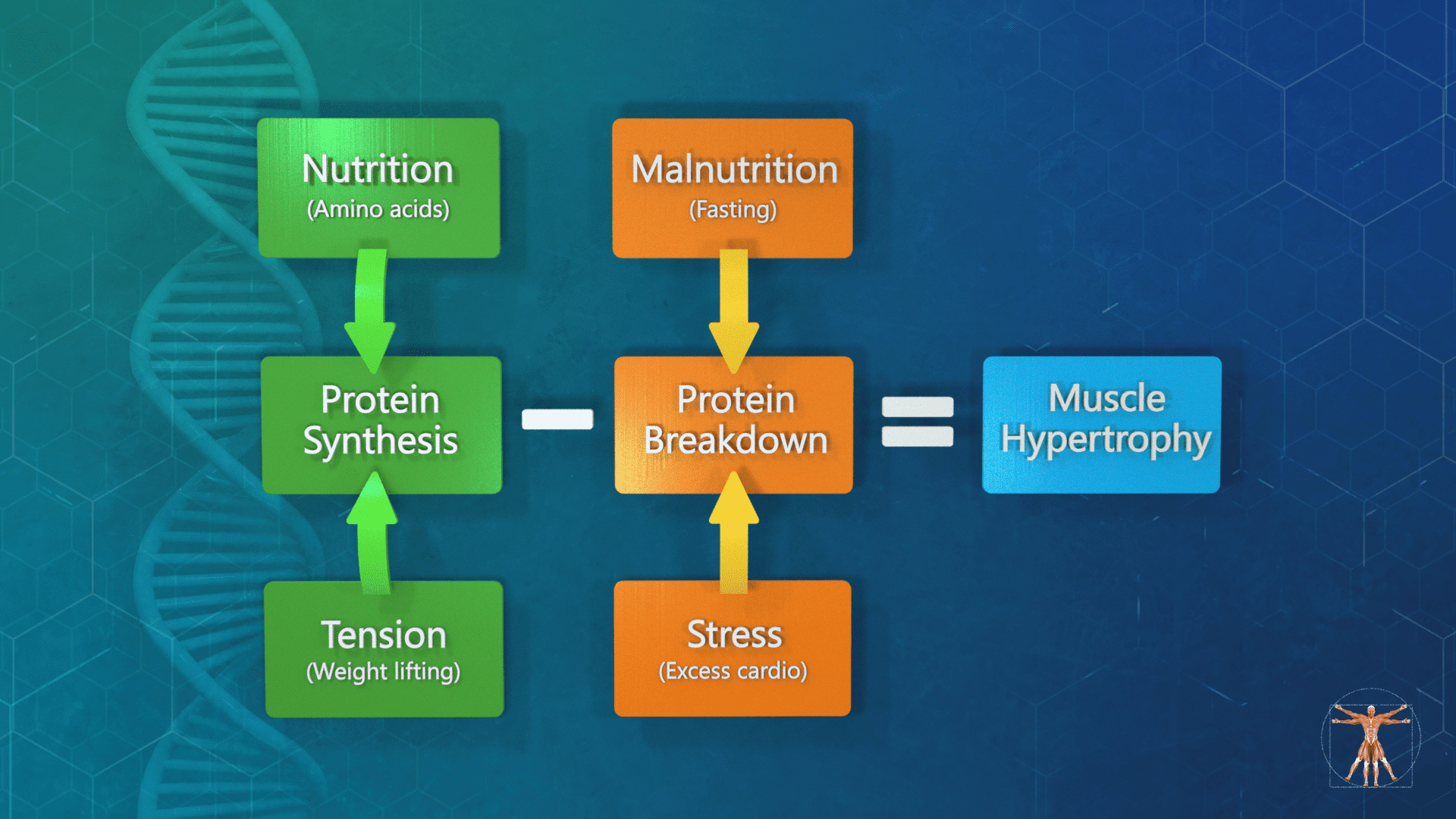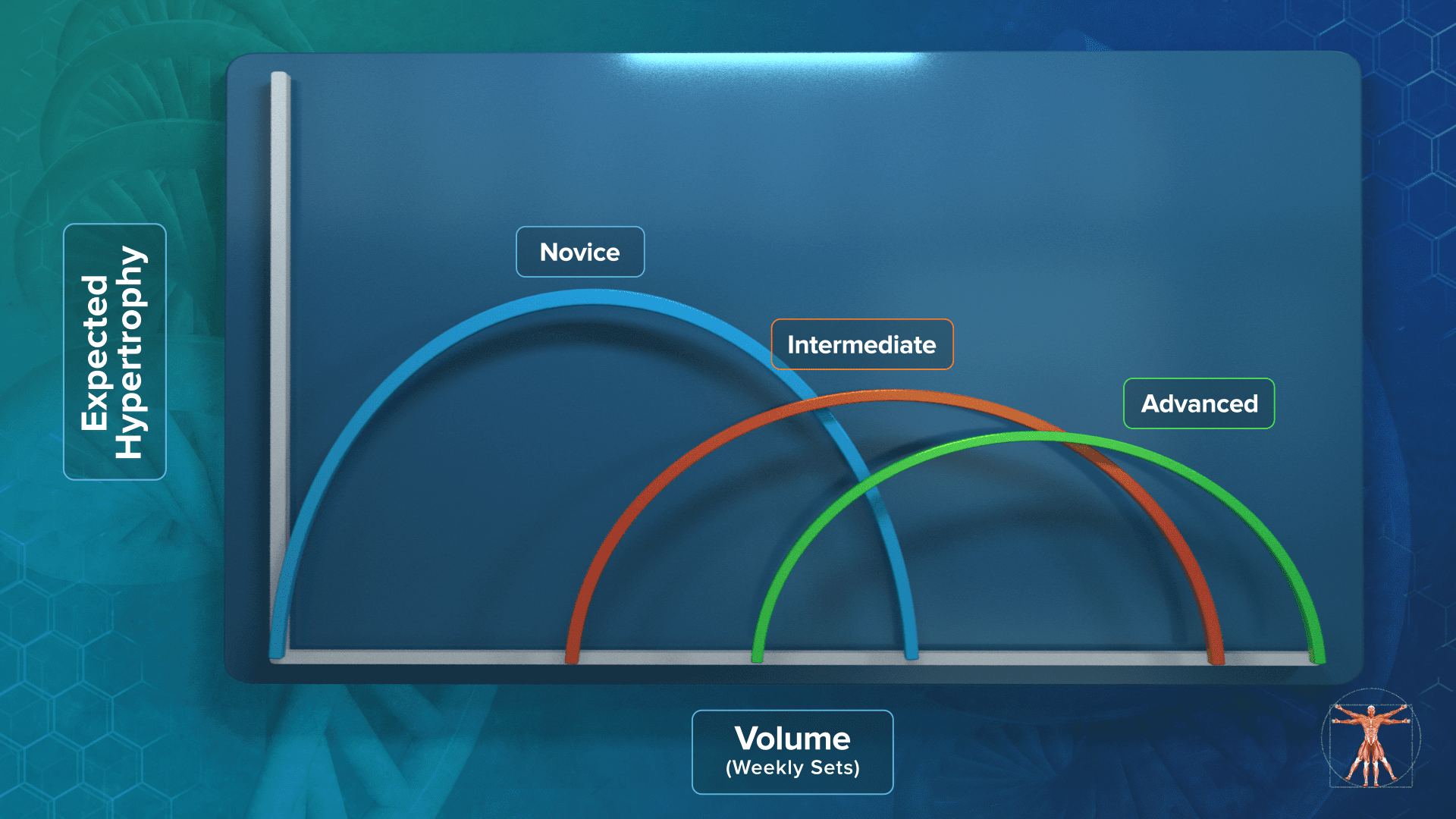Muscle Hypertrophy Workout for Beginners: Definitive Guide

So you want to work out for hypertrophy, but you’re not sure where to begin.
- Should you ask your buff friend?
- Trust bodybuilding magazines?
- Check out YouTube and Instagram?
Everyone seems to have their secret sauce, and it gets confusing fast.
In this definitive guide, you’ll see exactly what to focus on based on my years of experience coaching clients and getting a PhD in exercise physiology. We’ll talk about diet and training, how to split your workouts, the pros and cons of 4 training techniques to build muscle mass, and more. I’ll also give you the hypertrophy workout I use with most of my beginner clients.
Related: 3 Best Bodybuilding App for Beginners to Build Muscle Faster
What is muscle hypertrophy?
Muscle hypertrophy refers to the enlargement of muscles from an increase in the size of their cells. This is not to be confused with hyperplasia, which is an enlargement in a tissue due to an increase in the number of cells. Hyperplasia may, in some case, also contribute a small degree to increases in muscle mass.
While water accounts for approximately 75% of muscle volume, muscle growth is ultimately regulated by cellular protein metabolism. When the synthesis of new proteins exceeds the breakdown of existing proteins, muscle hypertrophy occurs. When breakdown exceeds synthesis, muscles will atrophy (shrink).
2 factors for muscle hypertrophy: diet and stress
There’s a myriad of factors that account for the degree of muscle hypertrophy, like age, gender, genetics, and hormones. But there are two factors we can control: diet and stress.
Mechanical stress placed upon the muscle, as a result of resistance training, will stimulate protein synthesis (Schoenfeld, 2010). An increase in available amino acids when protein is consumed will also initiate synthesis (Figure 1). Combine the two together, and a robust increase in protein synthesis follows. Do this consistently over several months and your muscles will hypertrophy! To learn more, check out this 1-min video:
Mechanisms of muscle hypertrophy
On the other hand, some factors can slow down or even reverse your muscle growth. Take calories (kcal). The cellular machinery responsible for muscle hypertrophy require about 2000 to 2500 kcal to synthesize one pound of new muscle. Consuming too few calories and amino acids will reduce protein synthesis and even increase protein breakdown.
Similarly, emotional/cognitive stress and too much cardio (hours per day, not 20-30 minutes a few days a week) leads to the secretion of hormones that breakdown proteins. Combine these two together and its recipe for muscle loss (Figure 1).
Figure 1: Factors influencing protein synthesis, breakdown, and muscle hypertrophy

Should beginners do hypertrophy?
Now that you have a general understanding of muscle hypertrophy and how to accomplish it, should one attempt to hypertrophy muscles when beginning resistance training?
The answer to this is a resounding YES! Muscle serves a variety of functions important for both health and performance, described in the table below.
Table 1: Muscle hypertrophy benefits
| Aesthetic | The lay terms “toned” and “ripped” describe an appearance of hypertrophied muscles and low body fat (albeit to a lesser degree for “toned”) |
| Performance | The force output of a muscle is directly related to the muscle’s girth. Muscle hypertrophy increases the potential for strength, speed, explosive capabilities, and reduced risk of injury. |
| Metabolic | Muscle accounts for a large proportion of the energy expended during exercise. Hypertrophied muscles increase the number of calories burned during exercise, and to a lesser degree while resting Muscle is the largest lean tissue site for glucose disposal. Hypertrophied and active muscles can reduce the risk of diabetes |
| Aging | Loss of independence, falls, and bone fractures in older age are closely related to muscular strength, even more so than cardiovascular endurance. The rate of biological aging (i.e.: how old you look and feel) is closely related to muscle mass, especially in women. |
But should beginners train specifically for muscle hypertrophy?
It depends. Muscles can hypertrophy when exposed to a wide swath of exercise protocols, and the less muscular and unfit one is, the less specific one needs to train. For example, a sedentary individual who takes up cycling or walking will experience some quadricep hypertrophy in the first few months.
When it comes to resistance training, a new comer should begin training within their capabilities and with protocols that meet their preferences. Weights as low as 20-30% of one’s maximum and repetitions as high as 60 to 100 have been shown to hypertrophy muscles in beginners.
However, as one becomes more hypertrophied, the type of training will need to become more hypertrophy specific (Figure 2).
Figure 2: Specificity requirements for hypertrophy

Muscle hypertrophy training methods
Over the past decade, a fiery debate has raged on social media platforms over the best training methods to hypertrophy muscles. Sometimes, these techniques are quite counter to each other (table 2), but still yield results.
What these techniques all have in common is they employ the use weighted external resistance, through a combination of machines, free weights, barbells, and dumbbells. They also target all the major movements and muscle groups.
Table 2: Hypertrophy training techniques
| Arrangement | Description | Pros/Cons | Bottom Line |
|---|---|---|---|
| Multiple Body Part Split Training | The trainee focuses on ½ to 1/3 the body per day | Pros: easy to focus on targeted muscles, each muscle can be trained 2-3 times per week Cons: individual sessions may be timely | This training method is appropriate and efficient for most trainees |
| Single Body Part Split Training | The trainee focuses on one muscle group per day | Pros: more specific muscle fatigue and greater focus on targeted muscle Cons: greater muscle soreness and lower training frequency | This training method may be useful for seasoned competitors with lagging body parts |
| Full Body Training | [Nearly] all muscle groups are trained in one session | Pros: More time efficient (days per week), more frequency Cons: individual sessions may take more time, lower weekly volume accumulation | This training method may be useful for novices or for maintaining hypertrophy |
| High Intensity Training (HIT) | The trainee performs very low volume (1-2 sets per muscle) but at a very high intensity of effort | Pros: Very little training time is necessary Cons: Volume is purposefully limited, and a high tolerance for discomfort is necessary | Less efficacious versus traditional paradigms, but may be useful for maintaining |
| Technique | Description | Pros/Cons | Bottom Line |
| Failure Training | All sets are performed until another repetition cannot be accomplished | Pros: more muscle damage and soreness Cons: longer recovery times, higher risk of injury | Training to failure is not necessary and failure sets should be used sparingly |
| Forced Reps | After reaching failure, a spotter assists the trainee perform additional repetitions | Pros: more volume, damage, and soreness Cons: longer recovery times, higher risk of injury, requires a partner/spotter | Forced reps do not seem to offer any advantage and should be used sparingly |
| Supersets | Two exercises for different muscles are done back to back without rest (i.e.: bicep curls followed by triceps press) | Pros: Increases training density (volume ÷ time in gym). Maintains a higher heart rate during a session Cons: requires open equipment and space. May not be appropriate for large movements (i.e.: squats followed by deadlifts) | Has demonstrated efficacy for hypertrophy and may increase training efficiency |
| Blood flow restriction | Cuffs or tourniquets are placed around the upper arm or thigh to impede the flow of blood out of the muscle | Pros: using heavy weights is not necessary Cons: must have a high threshold for discomfort. Cannot train non-limb muscles (i.e.: glutes, pecs) with this method | BFR training has demonstrated efficacy for hypertrophy. Its applications may include adding volume to lagging body parts or training around injuries |
Another time-tested method that’s gaining in popularity is rest-pause sets (we wrote a whole guide on it).
Try beginner muscle hypertrophy workouts for free with Dr. Muscle
Best beginner hypertrophy workout plan principles
Regardless of the of how you arrange your training or the methods used, there are four principles that should be considered when constructing any training program:
- Overload
- Specificity
- Variation
- Fatigue management
Overload principle
Overload is possibly the most important principle for muscle hypertrophy. Our muscles are incredibly adaptable, but will not hypertrophy unless the stimuli (overload) meets the threshold for adaptation. When the overload is presented again and again, at progressively higher amounts, muscle hypertrophy occurs. The more advanced the trainee, the more overload they will require to stimulate hypertrophy. In fact, overload is so important, we focus on it in our guide How to Progress your Training for Size.
Specificity principle
Specificity is selecting movements, volumes, loads, and speeds that match the outcomes you are trying to achieve. For example, performing sprint intervals on a cycle will not make you a better open water swimmer. In the same sense, performing calisthenics like burpees or jumping jacks may improve your cardio, but won’t provide enough tension to generate hypertrophy.
Variation principle
Variation is necessary to prevent plateaus in gains. Even with progressive overload, performing the same exercises, reps, and sets will eventually lead to diminishing returns and an increased risk of injury. When this occurs, it becomes necessary to change some of the exercises and the set and rep scheme. Just like overload and specificity, advanced trainees require more variation than novices.
Fatigue management
Fatigue management should provide time between sessions to allow for recovery and adaptation, and to reduce the risk of injury and burnout. If you played sports in high school or college, you may have felt worn down and less excited about practices as the season waned. The same will happen with resistance training when heavy, intense workouts are not separated by abbreviated periods of low effort training.
Guidelines for hypertrophy training program principles
Remember, the above principles should be implemented strategically. Table 3 gives some general guidelines.
Table 3: Hypertrophy training guidelines
| Principle | Implementation Guidelines |
|---|---|
| Overload | Increase the repetitions by 1-2 every other session for 4 weeks, then increase the load and repeat Increase the load by 2-3% every 2-3 sessions Increase the sets per exercise by 1 every 2-3 weeks for up to 6-8 weeks |
| Specificity | External resistance: barbells, dumbbells, machines Enough movements to cover all the major muscle groups (quadriceps, hamstrings, glutes, calves, pecs, deltoids, traps, lats, biceps and triceps) Bigger muscle groups require more movements/volume |
| Variation | Alter the rep and load scheme every 4-8 weeks (i.e.: begin with higher reps and lighter weight then change to lower reps and heavier weight) Alter some of the exercise selection every 4-10 weeks (i.e.: begin with bench press and pec deck then change to incline press and dumbbell flies) |
| Fatigue Management | Weekly: Provide at least a day of rest before training the same muscle group again Monthly: Perform a week of low-effort workouts (deload) once every 4-10 weeks |
Hypertrophy training sets, reps, and frequency
Now that you understand the principles, how should you set up a hypertrophy program? The main variables to consider are:
- Volume (including sets and reps)
- Load
- Frequency
Volume for hypertrophy
Volume is the amount of work performed, and can be visualized as the product of sets ✕ reps ✕ load. Studies overwhelmingly demonstrate the more volume performed, the greater the hypertrophy. However, the relationship between volume and hypertrophy follows an inverted U. That is, too much volume will compromise recovery, increase the risk of injury, and ultimately result in reduced hypertrophy.
The more trained one is, the more volume they require and the less the hypertrophic response will be (figure 3). For beginners, as little as 3-6 sets per muscle group per week may be adequate to stimulate robust hypertrophy. Advanced trainees may need 15-25 sets.
Figure 3: Relationship between volume, experience, and hypertrophy

There is a negative relationship between load and repetitions, in that the more reps done in a set the lower the load must be, and vice versa. Studies have shown hypertrophy can be achieved in beginners using heavy loads and low reps (i.e.: 4-6 repetitions) or light loads and high reps (>30), provided sets are taken to failure.
Repetitions for hypertrophy
When we consider the amount of effort, volume, and time committed to workouts, repetitions between 8 and 15 are the most efficient for stimulating muscle hypertrophy.
Frequency for hypertrophy
Frequency seems to be the least important variable to consider. There’s a slight benefit to training twice weekly over once, but little benefit to three times a week or more (Schoenfeld et al. 2016). Keep in mind that multi-joint movements will indirectly work the non-targeted muscle groups during once weekly split routines. For example, the deltoids will be worked directly on shoulder day and indirectly on chest day when doing presses.
Let’s recap in the chart below:
Table 4: Hypertrophy programming variable recommendations
| Variable | Recommendations | Considerations |
|---|---|---|
| Sets | 3 to 9 per muscle per week | More sets for large muscles (quads, glutes, chest and back) Less sets for small muscles (calves, biceps, triceps) |
| Repetitions | 5 to 25 repetitions | Low repetition sets require heavy weights, skill, and are not appropriate for all movements High repetitions require going to failure and tolerating a lot of discomfort (i.e.: burning sensations) Moderate reps are the most efficient |
| Frequency | 1 to 3 times per week | |
| Effort | End sets 1-3 repetitions shy of failure | High repetition sets may need to be taken to failure |
A full-body hypertrophy workout
What follows are three full body workouts to be done 3 days a week on non-consecutive days. To increase time efficiency, exercises in the same blocks are super sets. After 8 weeks, employ the principle of variation and select some new exercises.
Table 5: Hypertrophy workout example exercises
| Day 1 | Day 2 | Day 3 |
|---|---|---|
| Back Squat | Rumanian Deadlift | Leg Press |
| Leg Curls | Leg Extensions | Lunge |
| Bench Press Seated Row | Military Press Lat Pull Down | Dumbbell Press Bent Over Row |
| Lateral Delt. Raise Barbell Shrug | Triceps Press Down Barbell Curl | Peck Deck Rev. Peck Deck |
| Leg Raise Side Plank | Cable Crunch Side Plank | D.B. Side Bends Front Plank |
Table 6: Hypertrophy workout example progressions
| Week | Volume | Effort (reps shy of failure) |
|---|---|---|
| 1 | 2 ✕ 12 | 3 |
| 2 | 3 ✕ 12 | 2 |
| 3 | 3 ✕ 12 | 1 |
| 4 | 3 ✕ 12 | 0-1 |
| 5 | 3 ✕ 10 | 3 |
| 6 | 3 ✕ 10 | 2 |
| 7 | 4 ✕ 10 | 1 |
| 8 | 4 ✕ 10 | 0-1 |
Track your hypertrophy workout progress with a fitness app
You can track your progress on the workout above (and many more) inside Dr. Muscle, our smart workout app. It’s like a trainer in your phone. It automates your progress, and all the programming an expensive coach would charge you for. Plus, your workouts update in real time as you do them, and get more challenging automatically as you get in better shape.
Try beginner muscle hypertrophy workouts for free with Dr. Muscle
